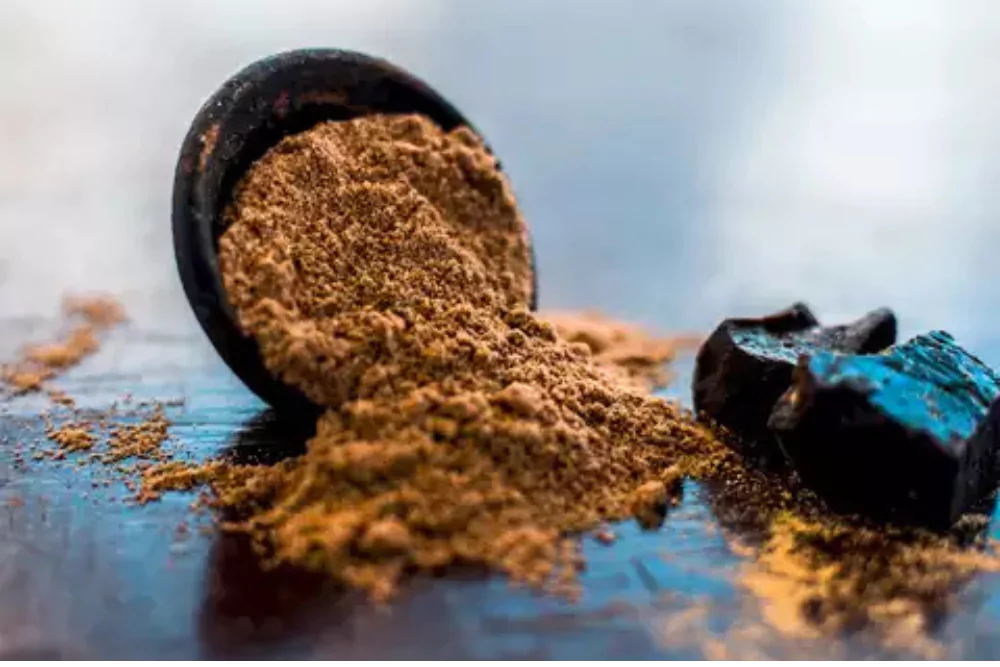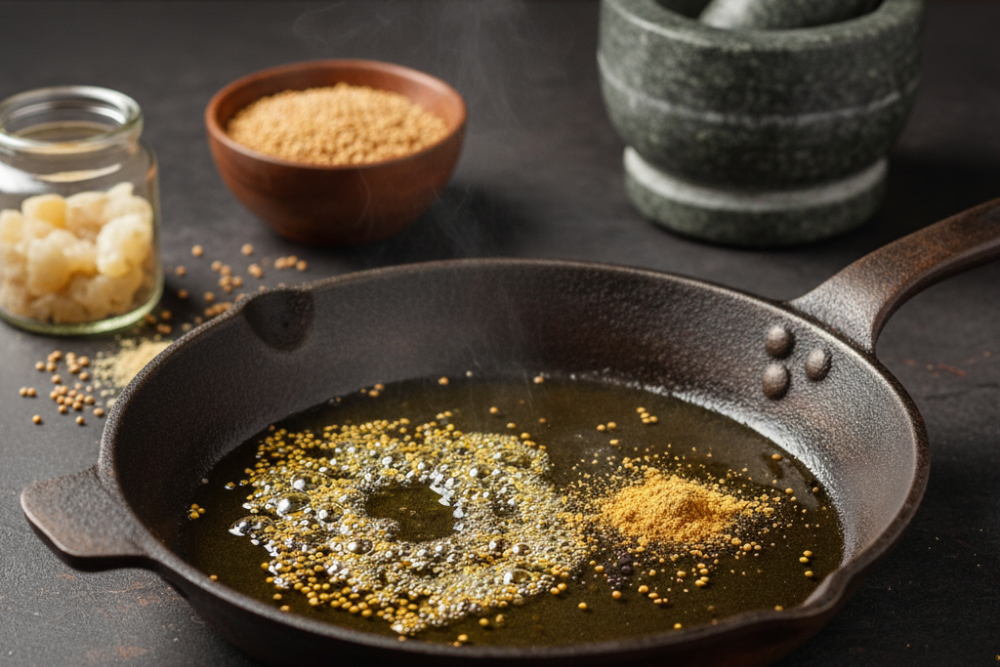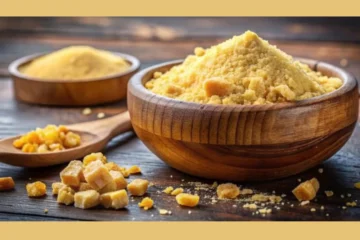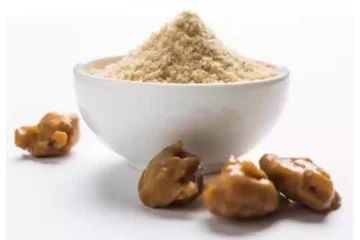Cooking with Hing and Mustard Seeds is a timeless Indian kitchen secret for elevating simple dishes with irresistible aroma and flavour. Whether you’re preparing dal, sabzi, or chutneys, the right balance of hing (asafoetida) and mustard seeds can transform your meal into something deeply aromatic and digestively comforting.
1. What’s the right way to temper hing and mustard seeds — which one goes first and how do I avoid burning them?
Short Answer (under 50 words): Always add mustard seeds first, let them crackle, then reduce heat and add hing. This order ensures the seeds release aroma and the hing doesn’t burn. Maintain medium heat and use fresh oil for best results.
Detailed Answer:
- Start with medium heat: Add oil or ghee and warm it till it shimmers, not smokes.
- Add mustard seeds first: Let them pop and release their nutty aroma. This step activates their essential oils.
- Lower the heat: Once they crackle, reduce heat to low.
- Add a pinch of hing: Stir quickly for 3–5 seconds until fragrant.
- Proceed with other ingredients: Add curry leaves, onion, or lentils immediately to prevent burning.
- Tip: If hing turns brown instantly, the oil was too hot—next time, lower the flame before adding it.
2. Which dishes taste best with hing and mustard seed tempering?
Short Answer (under 50 words): Dishes like dal, sambhar, poha, upma, lauki sabzi, and chutneys taste amazing with hing and mustard seed tempering. They add earthy aroma, depth, and aid digestion in both North and South Indian cuisines.
Detailed Answer:
- Dal & Lentils: The hing-mustard combo enhances the earthy flavour of dals like moong, toor, and masoor.
- South Indian dishes: Use in sambhar, rasam, or coconut chutney for a balanced, tangy aroma.
- Breakfast recipes: Add to poha, upma, or lemon rice to make them light yet flavorful.
- Vegetable curries: Lauki, tinda, or cabbage sabzi benefit from this mild tempering.
- Chutneys & pickles: Infuse mustard seeds and hing for that sharp, tangy twist.
- Digestive effect: Both ingredients aid digestion, reducing bloating after heavy meals.
| Dish Type | Best Use of Hing & Mustard Seeds |
|---|---|
| Dal | Tempering before serving for rich aroma |
| Sambhar / Rasam | Mustard seeds first, then hing with curry leaves |
| Poha / Upma | Light fry in ghee for subtle flavour |
| Vegetable Sabzi | Add before sautéing veggies |
| Chutney | Final tempering step before serving |
3. Can I use hing and mustard seeds in oil-free or low-fat cooking?
Short Answer (under 50 words): Yes. You can dry roast mustard seeds and bloom hing in hot water or low-fat ghee. This technique preserves aroma and flavour even without much oil, perfect for lighter or diet-friendly meals.
Detailed Answer:
- Dry roasting: Heat a non-stick pan and roast mustard seeds till they pop. No oil needed.
- Blooming hing: Dissolve a pinch of hing in a teaspoon of hot water or ghee substitute.
- Steam or sauté: Add tempered mix to cooked lentils or veggies after steaming.
- Use aromatic spices: Combine cumin, curry leaves, or pepper for extra fragrance.
- Try infused oils: Prepare mustard-infused water or light sesame oil for mild flavouring.
- Result: You’ll still enjoy depth and aroma without excess fat or greasiness.
4. What type of hing and mustard seeds should I buy — are there quality differences that affect taste or aroma?
Short Answer (under 50 words): Choose pure compound hing (not blended) and fresh mustard seeds—black for strong pungency, yellow for mild flavour. Quality and freshness directly impact aroma and overall dish balance.
Detailed Answer:
- Type of Hing: Opt for compounded hing with minimal wheat flour or gum—pure resin gives better aroma.
- Powder vs. Crystal: Powder is convenient; crystals are purer and long-lasting.
- Mustard seed types:
- Black mustard seeds – stronger aroma, best for Indian cooking.
- Yellow mustard seeds – milder and slightly sweet, good for pickles and dressings.
- Check freshness: Old mustard seeds lose pungency; store in airtight jars.
- Buy from trusted brands: Use reputable suppliers like Hingwala to ensure authentic hing and high-quality seeds.
- Storage: Keep in cool, dry places to retain potency and avoid moisture.
| Type | Flavour Profile | Best For |
|---|---|---|
| Black Mustard Seeds | Strong, pungent | Indian curries and tempering |
| Yellow Mustard Seeds | Mild, sweet | Salads, pickles, marinades |
| Compound Hing | Balanced aroma, easy to use | Everyday Indian dishes |
| Pure Resin Hing | Highly potent, sharp | Professional or Ayurvedic cooking |
5. How do I balance the strong aroma of hing — can it overpower the dish if I use too much?
Short Answer (under 50 words): Yes, hing can overpower dishes. Use only a pinch (1/8 tsp for four servings). Balance it with cumin, curry leaves, or ginger to round out flavours and maintain harmony.
Detailed Answer:
- Use minimal quantity: Hing is highly concentrated; even a pinch adds strong aroma.
- Balance with spices: Combine with cumin, coriander, curry leaves, or ginger to mellow intensity.
- Add at right stage: Add hing after lowering flame; this releases aroma without bitterness.
- Pair with ghee: Ghee tones down hing’s sharpness and enhances overall aroma.
- Avoid overmixing: Stir briefly—overcooking makes hing taste acrid.
- Tip: For lentils or soups, dissolve hing in water before adding to prevent uneven flavouring.
Conclusion
Cooking with Hing and Mustard Seeds is all about timing, balance, and quality. From tempering mustard seeds first to adding just a pinch of hing, every small step adds to the aroma and taste. These two ingredients not only enhance flavour but also promote better digestion. Use fresh, pure spices like Hingwala’s Hing and mustard seeds for authentic, aromatic, and wholesome Indian meals every time.





